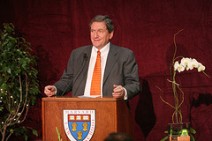
Getting away from the “science” of negotiation and back to its nature as “art”
Why teach the stories of individuals whose lives and careers have been so special? After all, most students of negotiation will never find themselves in the same situations as the notables they study. As much as we would like negotiation to be a science, with recipes that can be followed to produce the same wonderful results each time, the fact is that negotiation tends to be more of an art that succeeds or fails because of the skill of the chef. As Richard Holbrooke, the 2004 recipient of PON’s Great Negotiator Award noted in his acceptance remarks, “Negotiation is like jazz. It is improvisation on a theme. You know where you want to go, but you don’t know how to get there.”
A focus on great negotiators reveals the constant oscillation of varying negotiation dynamics and the way they require enormous creativity on the part of the negotiators. There is technique and there is art. The great negotiators indicate that you experience an intended outcome perhaps as often as an unintended outcome; your success in one context would have been impossible in a very different context, even if-or perhaps because-your technique and approach remained the same. It makes sense to remind students of this reality even as we teach what we believe are generalizable truths. We don’t want students to get trapped in an unrealistic expectation that the same approach will see them through each time. The stories of the great negotiators make this point quite clearly.
Agency vs. Context-a false duality?
Agency vs. context: which plays the most important role in a successful negotiation? PON’s Great Negotiator case studies series seems to say that both are important. Teaching a class that distinguishes great negotiators from great negotiations is an excellent way to emphasize the idiosyncrasies of each negotiation process while highlighting recurring themes and frequently-if not universally-essential skills and practices. One recurring theme in the series is that all great negotiators treat the set-up phase, as James Sebenius and David Lax call it in their book 3-D Negotiation, that comes prior to engaging in actual negotiations with great care. What they do during these pre-negotiations is quite arduous. Teaching from the case studies of great negotiators places the contextual complexity of negotiation alongside its method and rigor. As such, it adds “reality” to whatever academic framework an instructor chooses to use. The Great Negotiator series tackles both the context of notable negotiations and the unique styles of the negotiators who produce surprising results. The case studies are rich with the fluidity of the negotiation techniques that won the day. For example, the study of Charlene Barshefsky, U.S. trade representative during the Clinton administration and 2001 recipient of PON’s Great Negotiator award, highlights her use of “acoustic separation” – a technique that involves communicating different (not contradictory, but complimentary) things to different people, and the strategic importance of varying framing. The successful use of this technique is, by definition, dependent on her ability to adapt to the situation. Other great negotiators talk about a range of improvisations.
Humility and History: Great Lessons from Great Negotiators
When Stuart Eizenstat accepted his Great Negotiator award in 2003, he said, “I close this chapter in my life, and accept with great humility your award with one of my favorite quotes, from a book called Ethics of the Fathers (Pirkei Avot). I think it summarizes what our team, our administration, the Program on Negotiation, and perhaps all of us try to do … and that saying is, ‘it is not your obligation to finish the task, but neither are you free to exempt yourself from it.'” With one of the Holocaust survivors that inspired Eizenstat’s quest to reclaim property and achieve some restitution for victims of Nazi Germany sitting in the audience as he spoke, Eizenstat reminded everyone that his negotiation success came at the tail end of a story that involved a great many previous people and circumstances. He located both his inspiration to take up the task and his ability to succeed within its historical context.
Teaching from the Great Negotiator case studies imbues coursework with a human dimension that can shape students’ own approaches. When students are separated from the context surrounding negotiations, such as the case studies on the peace agreement process in Northern Ireland and conflict in Afghanistan, the mere description of methods and players can seem cold and detached. Hearing the stories of great negotiators, as they recount them, reorients students towards the importance of context. In addition, the Great Negotiators case studies, for all their emphasis on the exemplary nature of the spotlighted individuals, re-injects a sense of humility and a cognizance of the forces of history that shape each negotiation.
Ideas and Frameworks for Teaching Great Negotiators
If you are interested in using these case studies in your classes, what is the best way to build in or build on the stories of the great negotiators? We are not entirely sure yet. A number of faculty are experimenting with different models. A course might begin by invoking the 3-D (set-up; deal design; tactics) framework pioneered by James Sebenius and David Lax. The class would begin by reading an account of a well known case, absent the story told by the negotiator, and systematically analyze the context and situation, identifying barriers to the desired outcomes and suggesting promising strategies and tactics. Then, the class would listen to the negotiation story told by the “great negotiator,” analyzing and evaluating the great negotiator’s approach as well as searching for contradictions between the accounts of others and the negotiator’s own account. As they read (and listen to) additional Great Negotiator case studies, students can cumulatively assess and reassess, looking for evidence that the 3-D framework worked or didn’t work. Of course, many frameworks could be used. And, there are a lot of other ways of cumulating or juxtaposing the lessons from the full set of Great Negotiator case studies. The Clearinghouse at the Program on Negotiation is just beginning to document the experience of instructors who seek to integrate the Great Negotiator case studies into their teaching (in a variety of fields). We welcome accounts by instructors who are experimenting with new ways of using the Great Negotiator teaching materials.
Great Negotiator Case Study Series
Teaching negotiation using case studies focused on the efforts of great negotiators can help achieve several pedagogical goals at the same time. Developed by Professor James Sebenius of Harvard Business School, the Program on Negotiation’s Great Negotiator case study series, available from the PON Clearinghouse, highlights the lessons learned by each recipient of PON’s Great Negotiator Award from 2000 to 2014:
- Tommy Koh, Ambassador from Singapore (2014)
- James Baker, the former Secretary of State under the administration of US President George H.W. Bush (2012)
- Christo and Jeanne-Claude, the artists who created “The Gates” in Central Park (2008)
- Bruce Wasserstein, Chairman and CEO of Lazard, an international financial advisory and asset management firm (2007)
- Sadako Ogata, former United Nations high commissioner for refugees (2005)
- Richard Holbrooke, former United States ambassador to the United Nations (2004)
- Stuart Eizenstat, former U.S. ambassador to the European Union (2003)
- Lakhdar Brahimi, U.S. ambassador and the United Nations’ special envoy for Afghanistan (2002)
- Charlene Barshefsky, U.S. trade representative in the second Clinton administration (2001)
- George Mitchell, former U.S. Senator, for his work in Northern Ireland (2000)
This diverse group of individuals represents a range of what it means to be a “great” negotiator and allows instructors to draw on living examples whose successful negotiations show why negotiation is as much an art as it is a science and how and why context matters. Some of the Great Negotiator case studies include video materials incorporating what the award recipients said during the seminars that PON organized in their honor.
Great Negotiator 2004: Ambassador Richard Holbrooke (DVD)
A DVD featuring Ambassador Richard Holbrooke discussing his role brokering the Dayton agreement that ended the 1992-95 war in Bosnia as well as his role in resolving the multinational dispute over U.S. dues owed in arrears to the United Nations.
Great Negotiator 2003: Stuart Eizenstat (DVD)
A DVD featuring excerpts from a discussion with Stuart Eizenstat regarding his efforts negotiating reparations for victims of Nazi Germany.
Stuart Eizenstat / Negotiating the Final Accounts of World War II
A factual case study regarding former EU Ambassador and Deputy Treasury Secretary Stuart Eizenstat’s work negotiating reparations for victims of World War II.
Lakhdar Brahimi / Negotiating a New Government for Afghanistan
A factual case study regarding former UN Special Envoy Lakhdar Brahimi’s involvement in negotiating an interim Afghani government in 2001.
Charlene Barshefsky (A) and (B)
Two factual case studies regarding former U.S. Trade Representative Charlene Barshefsky’s negotiations with China regarding intellectual property enforcement.
“To Hell with the Future, Let’s Get On With the Past”: George Mitchell in Northern Ireland
A factual case study regarding George Mitchell’s involvement in the 1996-98 Northern Ireland peace negotiations.
Written by Larry Susskind and Jessica Corsi, taken from the bi-annual e-newsletter Negotiation Pedagogy at the Program on Negotiation E-Newsletter (NP@PON), which can be found here.
Related Negotiation Skills Article: When to Make the First Offer in Negotiation
Originally published in 2010.






PON Great Negotiator awardee Charlene Barshefsky might have been great from a broad American perspective (although I have met Americans who think she cost them their jobs because she was no match for the Chinese). My research in the late 1990s and early 2000s identified several veteran trade negotiators who thought her less than great. Of course, their attitude to her may be nothing better than sour grapes. Nonetheless, read the following extract from my book and make up your own mind.
“One of the reasons the World Trade Organization negotiations failed at Seattle in 1999 was said to be the autocratic attitude of the US Trade Representative, Charlene Barshefsky, who chaired the meeting with a touch of annoyance because the USA could not control the agenda as it had during GATT negotiations. She countered by trying to treat the negotiations as bilateral rather than multilateral, and so caused regular delays in plenary sessions by prolonging meetings with individual countries. According to Geoff Raby, the lead Australian negotiator at Seattle, delegates in general were [annoyed] by Barshefsky as master puppeteer and chief ‘head-butter’. She worsened the normal tension in the WTO between bilateral ‘horse trading’ and multilateral ‘Geneva driven’ negotiations.” (Tug of War etc, 2010, p. 241)
PON Great Negotiator awardee Charlene Barshefsky might have been great from a broad American perspective (although I have met Americans who think she cost them their jobs because she was no match for the Chinese). My research in the late 1990s and early 2000s identified several veteran trade negotiators who thought her less than great. Of course, their attitude to her may be nothing better than sour grapes. Nonetheless, read the following extract from my book and make up your own mind.
“One of the reasons the World Trade Organization negotiations failed at Seattle in 1999 was said to be the autocratic attitude of the US Trade Representative, Charlene Barshefsky, who chaired the meeting with a touch of annoyance because the USA could not control the agenda as it had during GATT negotiations. She countered by trying to treat the negotiations as bilateral rather than multilateral, and so caused regular delays in plenary sessions by prolonging meetings with individual countries. According to Geoff Raby, the lead Australian negotiator at Seattle, delegates in general were ‘pissed off’ by Barshefsky as master puppeteer and chief ‘head-butter’. She worsened the normal tension in the WTO between bilateral ‘horse trading’ and multilateral ‘Geneva driven’ negotiations.” (Tug of War etc, 2010, p. 241)